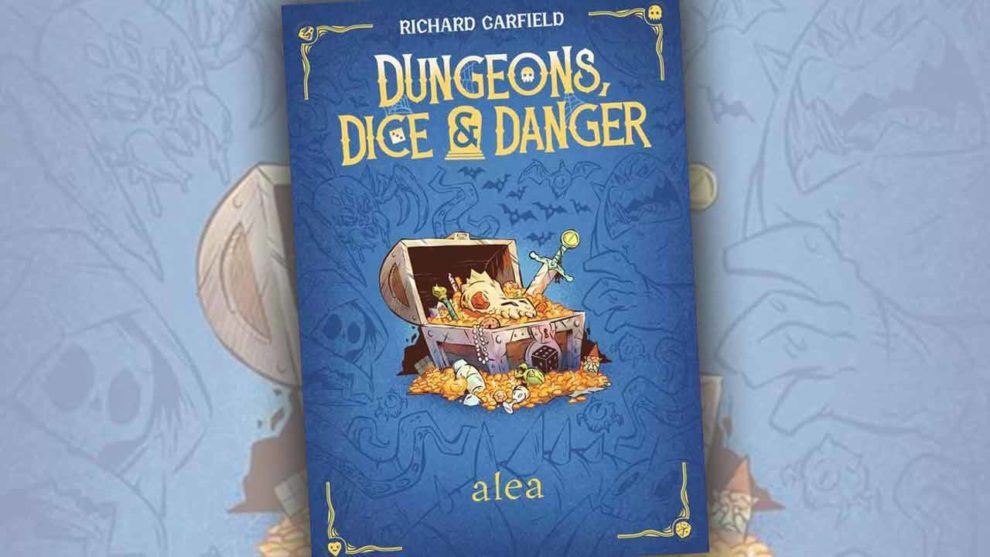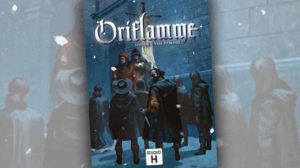When I think of legendary game designer Richard Garfield, I think of Magic: The Gathering, KeyForge, SolForge: Fusion, and Robo Rally. Oh, and vampires and bunnies. I don’t think, however, of dice. Danger, certainly, and occasionally, dungeons.
I recently received a review copy of Garfield’s 2022 roll-and-write design Dungeons, Dice & Danger from alea, the strategy game imprint that is a part of the Ravensburger publishing empire. It was only a matter of time before Garfield designed a roll-and-write since, well, roll-and-writes (RNWs) are a part of life in the tabletop space nowadays.
I don’t think of this as necessarily good or bad. I’ve enjoyed some of my RNWs, such as Dinosaur Island Rawr ‘n Write and the now-classic design Railroad Ink. My main RNW criticism is that too many have flooded the market in the last 2-3 years that are stripped-down versions of other full-sized games I enjoyed more.
That’s what makes Dungeons, Dice & Danger so welcome here at my home: it’s an original design, it’s easy to teach, and it can (or should!) be played at a crowded bar or a busy home.

Scratch Off
Dungeons, Dice & Danger puts players in the shoes of future heroes, diving into a dungeon to find treasure and a decent amount of danger. That danger is faced by rolling five standard D6 dice—four white, one black—and using the results to navigate a dungeon full of rooms that each have a distinct number from 2-12.
Before each game begins, the players collectively decide on one of the four available maps, scaled by difficulty. (The box has dozens of sheets of paper, each double-sided and showing one of the four dungeons available.) All of the maps are laid out in similar ways, with green start spaces featuring all of the possible pair combinations and other spaces that delve deeper into the dungeon with other numbers, dice symbols, monsters, and treasure.
On the active player’s turn, they roll the five dice and have access to all five to make two pairs. No one moves any dice, though. You have to just use your mind to make those pairs, not shift the dice around for each player. The passive players (or in the case of solo play, the only person at the table) must use only the white dice to make their pairs, giving the active player the most flexibility each turn.
Starting from the green spaces, turns are simple: cross out two numbers aligned with the pairs you’ve created with the rolled dice. Let’s say a three, four, six and a six were rolled on the white dice. Passive players would have to make pairs from those numbers. I’ll go with forming a 7 and a 12, although I could have gone with a 9 and a 10, etc.
Looking at my sheet, I could cross off a 7 in my green spaces, then cross off a 10 if one was adjacent to that 7. Or, I could cross off the 7 and the 10 in my start spaces. Once a space is marked, future moves into the dungeon must be adjacent to any previously-marked square. When a player marks off any space next to a monster, future pairs can be applied towards damaging a monster, assuming that monster has a number that aligns with your die rolls.
Other spaces might score gems, worth points at the end of the game. There are map-specific spaces aligned with set collection, minor treasure rewards like gold, and special abilities that grant players more health or access to the black die as a passive player. (To begin play, each player can use the black die three times per game as the passive player, but this can increase during play.)
If a player can’t make a pair, they take one damage. Take too much damage, and players lose a lot of end-game victory points…and if you take enough hits, you’ll die in the dungeon and be eliminated by the game. This is rare in my experience, and it is noted as such in the excellent rulebook.
A game of Dungeons, Dice and Danger ends when the players collectively defeat all of the monsters on the map. Damage points are subtracted from player scores, producing a winner with a score that usually ranged in the 60-80-point range during my four tries at the game.

Have Pen, Won’t Talk
One of the folks in my review crew had just finished his first play (my fourth) of Dungeons, Dice & Danger, and he had this to say about the experience:
“It’s like playing bingo in the church basement on a Tuesday.”
Dungeons, Dice & Dragons only has two consistent issues, both of which are avoidable.
The first issue, as noted above, is the lack of interaction. Dungeons, Dice & Danger is a quiet sit. There you are, occasionally chatting, sometimes announcing that you’ve beaten a monster (which gives all other players a small bonus), cursing the moon when someone rolls a bunch of bad dice pairings that cause them to take damage.
But here’s how I got around that one: add liquor. Play some good hip-hop. Maybe play this game while at a great bar near your home that constantly supplies good music, since you won’t need to really talk to anyone!
My second issue concerns the length. Dungeons, Dice & Danger takes too long to play, especially with more than a solo player. That’s because you will sometimes take turns where you will mark off two spots in quick succession that line up with pairs you were hoping to roll. On many other turns (this was particularly true with three players), you will mark spaces as visited on your sheet, then watch others go through the process of finding the “best” spaces to mark off, and no one can do anything until everyone is ready.
Dungeons, Dice & Danger complicates this further by providing maps that are a bit too large. Now, when I played this game solo (on expert, which ended up being quite a comedy as I got blown off the table), I played it for 20 minutes and got to roll dice a ton while finishing a drink at my basement bar. No problem—no one is waiting on me, I can move through turns quickly, and I can enjoy the game all by myself to play out a high-score challenge.
If you set the table just right, Dungeons, Dice & Danger turns into something else entirely: a very pleasant, solo RNW that passes the time quite nicely while you’ve got a casserole in the oven, waiting for a child to break in with a “very important” question about their LEGOs.

Solo, Background Music, Beer, Pretzels
If you play Dungeons, Dice & Danger with the right selection of accessories, it’s a fun time. This won’t replace some of my favorite RNW games but the experience was consistently engaging and works well with a family of gamers, even younger ones despite the game’s 12+ age recommendation. My six-year-old took long turns, but he picked up what needed to happen just fine, and after our games ended, he just grabbed a fresh sheet and played by himself. (Don’t worry—no bourbon for the kids.)
The artwork and the monster names on each dungeon sheet are amusing fare. The game is so easy to teach that it can work for gamers and those newer to the hobby with ease. I complain sometimes that these RNWs need to have more sheets if they don’t use dry erase boards—not a problem here, because there’s no shot I’m playing this 200 times. Thanks to the production team for giving me a bit more than I need to ensure that I have enough supplies.
I’ll be sticking to this game’s personal sweet spot: solo play. Now I just have to find a dungeon dive playlist that pairs well with the bourbon I’ll be sipping while playing!












Add Comment